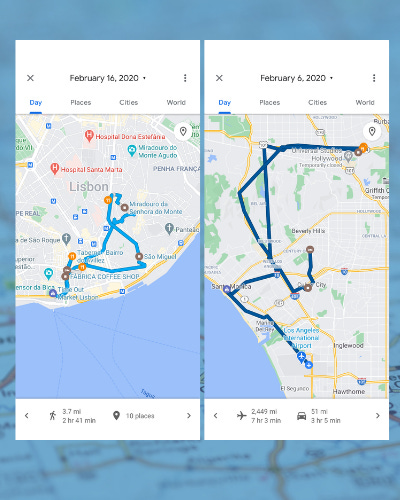
Location, location, location
Every single one of your customers carries a device with them that pings their location...all...day...long. How is this not already an integral part of your digital marketing strategy? It's not easy.
Location is one of the most undervalued digital media capabilities because most marketers do not understand its power. The geospatial category is on its way to becoming a $96 billion market, and advertisers have barely dipped their toes in the water.
If you asked any government intelligence official to list their "Top 3" most critical data assets, location would certainly be on that list. That alone should both pique your interest and terrify you. That’s probably why it is a bad idea to take your mobile device with you if you plan to take part in an insurrection.
The most overused use case ever
Raise your hand if you've heard this use case for location data. It starts with: "A consumer is walking past a Starbucks, and their phone pushes them a coupon for $1 off a coffee."
Substitute Starbucks with any retail storefront. We've all heard some version of that example at least a hundred times. It is both comical and absurd because I've never heard of a marketer executing that style of campaign successfully. Yet, it is used as the quintessential example of location data in digital marketing.
Creating a serendipitous user experience is the dream, but it is unlikely to be a successful campaign strategy at scale because of a fatal flaw. It assumes consumers are just waiting to be interrupted by an invitation to come spend their money on things they didn't realize they needed, right this second.
A better way
There are better, more effective uses for location data that extend well beyond opportunistic ad targeting. Here are just a few examples of how location data can be used to create sophisticated campaigns, including:
- Curation of a customer’s journey
- Segmentation of audiences based on real-world movements
- Segmentation of audiences by inferred-interest
- Segmentation of audiences users by physical cohorts
- Attribution and outcome measures
- Quantifiable behavioral changes
- Predictions of future sales volume
Examining the asset
Let's first take a look at the raw data assets we have at our disposal. Obviously, most consumers have a smartphone physically on their person or within reach for 99.9% of their waking lives. It is an extension of the body and soul. Here are just a few examples of the mobile touchpoints in our daily lives:
- The phone literally wakes us up in the morning, serving as the all-important alarm clock.
- It's our morning news source. As we lay in bed, attempting to motivate ourselves to get up and face the workday, a quick news and social media scan is in order.
- It's our workout companion. If you are the sporting type, your phone likely accompanies you on the morning jog or trip to the gym.
- No one knows your coffee order better. The commute wouldn't be complete without a quick pitstop for a 5 cream + 2 Splenda Dunkin' coffee or extra-foam-skinny-latte-with-sprinkles at Starbucks.
- Workplace pinball. That little device is with you as the workday bounces you around while you check your email, place calls and Zooms. Plus, who can resist the temptation to check Twitter/Facebook/Instagram?
- It is 5 o'clock somewhere. It is time to head home, but first, a quick stop for some dinner ingredients at the grocery store by the house.
In just six hops, we now know where this example consumer lives and works. We also know where they like to get their morning coffee, which grocery store they visit regularly, and how often they typically shop.
Taking it a few layers deeper, we also know the locations this person visits for work, how often they travel for work, and the average distances from home and the main office they venture. Starting to get creepy? It's only just begun.
Through some basic cohort analysis, we can ascertain that the consumer lives with one adult age person (likely a spouse) and a teenage child since all three devices are observed together every night by 9PM. Two of the devices head off to offices at 7AM, while the other heads to the local high school. Using the same techniques, we know all of a consumer's coworkers since they spend 8 hours a day, Monday through Friday, together in the same office building.
As you are probably starting to see, just a basic understanding of how a smartphone moves through time and space during the typical consumer's day has the potential to generate an unholy amount of valuable data. We did not have to know any other PII data about the consumer in order to do this. We did not need their name, email address, social media handles or phone numbers. All we needed was a periodic set of coordinates, a time stamp, and a persistent (anonymous) device ID.
Look at your own data
Up for a little adventure? Taking a peek at what the platforms know about your location history can be...sobering. Let's see what they already know about you.
Let's use Google as an example. Whether you are an iOS or Andriod user, Google makes some attempt to capture your current location on a regular basis through a multitude of owned and operated apps. This is in addition to capturing a bit of location data along with every Google search you do.
Business Insider has some quick instructions for checking out your Timeline in Google Maps. Here are some of my Timeline datasets from my last two trips before the pandemic struck.

Google apps are just some of many that collect similar data. The wireless carriers themselves track location for devices connected to their networks. Then there's a whole world of fascinating applications for Wi-Fi access points and beacon technology.
What the where?

Location capture only answers half the question for most marketing applications. It answers where and when a consumer was located. However, it is often important to know what is located at each capture point. That is where Point of Interest (POI) metadata comes in.
Location data will show you where a device was located at a specific point in time but that’s basically it. A pinpoint on an otherwise blank map. No other details about the physical space around that pinpoint. When our example consumer stopped for a coffee, all we knew was that they stopped at a particular location. At the time, we had no idea it was a Starbucks.
POI data will tell us that it was a commercial business. Furthermore, it shows us that it was not just any commercial business; it was a Starbucks or a Dunkin' Donuts.
Campaign thought starters
Here are just a few quick ideas for the application of location data to your next campaign.
- Birds of a feather. Most consumers tend to associate themselves with people that are “like” themselves. People with young kids tend to hang out with other families that have young kids. People they work with tend to make around the same amount of money as each other. Once you’ve identified the patterns of your ideal customer, there’s a good chance you can extend that audience to their nearest cohorts and still end up on target.
- Location and time are linked. If you notice that your existing customers tend to visit your retailers every 8-10 days, use that to your advantage. Don’t bother sending them ads the day after they went to the store, it’s too late. Pick up the messaging a few days out as they start to run low on the products in your category.
- You can lead a horse to water. Consider incorporating “visitation” into your attribution models.
- Exclusion is as important as inclusion. Is your product generally purchased (or picked up curbside) at a physical location? How far are your consumers willing to travel to visit a store where your product is sold? In the rural midwest, it is not uncommon for people to drive over an hour to visit the nearest big-box retailer. In suburban New York, that’s more like 15 minutes. Make sure your ad spend does not extend beyond the physical distance your consumers are likely to travel.
- Households are not that important. Before COVID-19, most people spent more of their waking life at work than they did at home. Most consumers are just as likely to visit the store closest to their job as they are to the store closest to their homes. Location data can separate homes from workplaces to enable experimentation.
We spend a lot of time in our industry talking about audience segmentation based on online and offline behaviors, demographics, past purchases, etc. It isn’t surprising that we default to these techniques because they are easy. They are sitting there for us to pick up off the shelf and use. Clever use of location data is only slightly more complicated but infinitely more clever.
The continued deprecation of browser cookies creates an opportunity for marketers to rethink their go-to-market strategies. Carve out some time and resources to explore location for 2021.

Want to get started? Here’s the next steps on your location journey.
- Understand what you already have. Chances are, you probably have some location data at your fingertips. It might not be readily accessible, but it is probably there. CRM, CDP, website analytics, and ad servers are great places to start. Locations, time stamps, and anonymized device/user ID’s are what to look out for.
- Sketch out the theoretical life of your best customers. Where do they go? Where to they shop? Where do they travel for business? Where do they travel for pleasure? How far do they venture from home each day? Is it densely populated or pretty rural? Get a good understanding of how you think these customers move through the world on a typical day. Then find out if it is true…see next.
- Map the capture points and key POI. Once you think you have an idea of how your customers move through the world, generate a list of all the important location touchpoints. Do you need to know if they visit grocery stores or pharmacies? Would weekday visitation of a school tell you that the person is probably a parent? [Yup] Do they travel more than 40 miles a day? If so, they probably also visit a gas station more often than most people. Does that matter to you?
- Search YouTube. I feel like I write this in every newsletter, but it is true. There is an enormous library of location and geospatial webinars available on YouTube right now. Go hear it from the experts and vendors themselves. Learn the terminology and get a clearer understanding of applicability to your business case.
- Start designing experiments. Plan to run some head to head tests against your incumbent audience targeting strategies to see if location-based approaches deliver as-good or better results.
This field is truly fascinating. If you're a tech nerd like me, you’ll be blown away by the possibilities.

🚗 How long will it take me to stop saying FCA and start saying Stellantis?
🦚 Can you smell what the Peacock is cooking?
📈 “You might also be interested in…these SPACs” says Taboola.
👩🎓 Columbia University’s engineering department is teaching online marketing.🤔 Here’s the curriculum.
🏆 And the Emmy award for System to Measure Video Performance and Demographics Across Multiple Platforms goes to…Nielsen. Something tells me they’ve got a lock on next year too.
▶️ NBC News products might end up getting more viewership on YouTube than they do on NBC.
Support Independence
Getting the FREE AdLingo newsletter supports independent commentary, education, and insight into digital advertising.







